This article breaks down Saturdays matchup between Memphis Derrick Rose and Gonzagas Jeremy Pargo, two strong and athletic point guards who may meet again sometime down the road.
The Setting:
This game was a break from conference schedule, something Memphis and Gonzaga have done the past two years for mutual benefit, to strengthen their schedules that often suffer from lack of conference competition.
The game was a Saturday afternoon game at FedEx Forum in Memphis, where Memphis stood 18-0, one of only two remaining unbeatens in the country. Gonzaga came into the game with a respectable 15-4 record, but with the strong play of St. Marys, were no longer the favorites to win the WCC. Both teams could use the win, and behind Jeremy Pargo, Gonzaga was ready to give Memphis one of its toughest tests of the season.
The Participants:
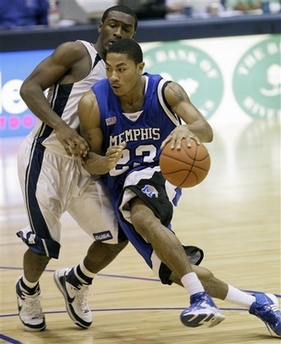
In one corner, we have 19-year-old Derrick Rose, a 64 point guard who is one of the most highly touted players of this freshman class. Some have questioned Roses true point guard abilities, due to his meager average of 4.4 assists per game, but no one questions his outstanding physical tools. Rose is currently projected as the second overall pick in the DraftExpress 2008 mock draft.
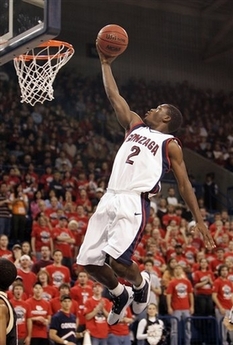
In the other corner, we have 21-year-old Jeremy Pargo, a 62 point guard who has made noticeable strides with his game in all of his three years at Gonzaga, going from a sparkplug reserve to the teams starting point guard, now averaging 6.1 assists per game. The brother of the New Orleans Hornets Jannero Pargo, Jeremy is not nearly as touted as Rose, currently projecting as a second round pick in our mock draft after his senior year.
The Outcome:
When the game was over, Memphis came away victorious once again, bringing their season record to 19-0, but only after a toughly contested battle with Gonzaga. Memphis held a lead in the five to ten point range for most of the game, but could never fully pull away, and at one point just prior to the end of the first half, Gonzaga actually took the lead temporarily. In the end, Memphis attack was just too much for the Zags, and they werent able to close the gap, losing 81-73.
To start the game, Rose didnt have the assignment to guard Pargo, and that was the case for most of the game aside from just a handful of plays. On the other end, Pargo started off matched up with Rose, and kept that assignment for a decent part of the game, but Gonzaga used a lot of zone defense as the game went on, so we didnt see consistent one-on-one action between the two on either end of the court, though there were a few notable exchanges. And even though they werent matched up with one another, both clearly brought their best to the table for this game, as both were the aggressors for their teams, leading the offensive attack.
The game didnt get off to a great start for either point guard, as both threw turnover passes in the first few possessions, with Rose trying to do too much on a transition play and Pargo throwing a pass that his teammate couldnt handle in a half-court set. Things definitely picked up from there, though, with Rose getting going first. Rose was really pushing the ball off rebounds in the early going, leading the break and finding open shots in transition, dishing out two assists for open three-pointers early. He did most of his creating for teammates in transition, dishing out for made 3-pointers and lay-ups alike throughout the game, while also creating many open shots that his teammates didnt convert. He did make some blunders in transition as well, carrying the ball on one occasion, and forcing up a bad shot attempt in the lane on another, when he was clearly trying to do too much with the ball.
Rose was also very impressive in the half-court, especially in his attacking of the basket, where he used his extremely explosive first step to get into the lane at will. He used screens on occasion, but for the most part, got past his man in isolation situations, using his first step in combination with crossovers going from right to left and left to right. His crossover is very strong, and he was able to sell it consistently whenever he used it. Rose showed outstanding ability to accelerate from the perimeter, going from a very complacent-looking pace to full speed in just one power dribble, with his defender left behind. Rose really made use of his right-handed floater in the lane in this game, using it on the vast majority of his forays into the lane, converting with it in space or when taking contact from the defense.
Rose also did some creating for teammates in the half-court, throwing some nice alley-oop passes, finding open shots from the outside, and doing a good job managing his teams offense in general. In terms of other ways he contributed for his team, he hit one spot-up three-pointer, which is an area hes improved on since his high school days, and also showed off some very nice ability on the boards. On one of the most impressive plays of the game by any player, Roses teammate Joey Dorsey was going into a move in the post while Rose was standing at the top of the key. Rose started heading towards the basket as Dorsey was putting up his shot, and exploded through the defense with outstanding speed and elevation to go up high for a put-back dunk, something you dont see from point guards very often.
Rose did have some blunders in the game, notably some turnovers in transition and some forced drives into the lane that led to missed shots or turnovers, but for the most part he played under control and did a good job creating offense for himself and his teammates, while playing solid defense throughout and really impacting the game in every way possible. He finished the game with a near triple-double, with 19 points, 9 assists, and 8 rebounds, for what was probably his most impressive overall performance of the season.
On the other side of the matchup, Jeremy Pargo also had one of his more impressive performances of the season, putting up 25 points and 7 assists with just 2 turnovers, while playing all 40 minutes for the Bulldogs. Pargo played his usual very aggressive style on both ends of the court, which bordered on too aggressive at times, something that has hurt him in the past.
Pargo did most of his damage in half-court sets, creating offense for himself and his teammates in various ways. While he did a good job moving the ball on the perimeter to find open shots for his teammates, leading to a few assisted three-pointers, Pargo does most of his damage getting into the lane, using his strong first step and combination of crossovers, spin moves, and hesitation dribbles to consistently get past his man. He had quite a few drives with a complicated series of moves in this game, using all the moves in his arsenal to weave through the defense, finishing with floaters and lay-ups with his right hand at the rim. One thing Pargo does an excellent job of is improvising in the lane when he seems to be in trouble, doing a great job holding his pivot foot when deep in the lane, proceeding to use fakes, and his strong upper body to still create a high percentage shot when his drive appears to be stopped.
Pargo seemed to over-penetrate a lot in this game, though he did a good job getting out of trouble, showing very good court vision, and making strong passes out of the post to open teammates across the court. Pargos upper body strength is very evident in his passing in general, as he often dishes very strong, quick, and precise passes across the court, be it hitting a cutter under the basket from the perimeter or driving into the lane and dishing out.
While Pargos end box score looks outstanding, he did have a few problems, forcing a bad pull-up jumper from the mid-range on one occasion, and air-balling a three-pointer on another. Also, he seemed to get lucky on a few of his over-penetrations, as some of those could have easily turned into turnovers for him. Overall, though, Pargo did an excellent job keeping his team in this game against a true powerhouse in Memphis, which is a terrific feat considering the type of athletes he was matched up against.
Preliminary Conclusions:
While both of these point guards hail from Chicago and have a similar aggressive, attacking style, theyre very different prospects who have taken very different paths to where they are today. While its still early to draw definitive conclusions on either player, both appear to have bright futures ahead of them, and both should be playing in the NBA soon enough.
Derrick Rose came into this season hyped as one of the best freshman in this class, and with that hype, came some very lofty expectations. Roses 4.4 assists and 3.0 turnovers per game dont exactly lend themselves to the Jason Kidd-style pure point guard comparisons that Rose has drawn, and the fact that this was just his second game with more than 6 assists on the season isnt very encouraging either. But as always in these cases, its important to look deeper than the stats when scouting NBA prospects.
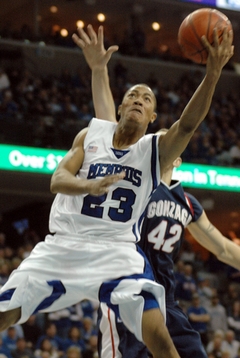
As shown in this game, and in flashes throughout the season, Rose does have very good court vision and the ability to create for teammates every way a point guard should be able to. He makes assists by pushing the ball in transition, finding open shots in the half-court, and driving-and-dishing in the lane. His decision-making with the ball has been questionable at times, most notably with him forcing some bad shots in the lane over the course of the season, but there are other reasons hes averaging just 4.4 assists per game.
First, Memphis offense spreads the ball around a lot, taking the ball out of Roses hands, and there are also many capable offensive players on the team, ones who dont need shots to be created for them. They dont run many pick-and-rolls either, something that is a staple of most NBA offenses, and leads to many assists for point guards. Its also worth noting that Rose did come onto a Final Four team with all five returning starters and most of its returning depth, so the team clearly has plenty of talent. Also, at 19-0, theyre clearly doing something right, and Rose as the second leading scorer and leading assist man has a lot to do with that.
When looking at Roses game, its important to note that playing this role for Memphis, which takes away some of his game managing responsibilities, could help make him a more dynamic player in the long run, as it forces him to focus more on his scoring, giving him more confidence in that area. This can already be seen noticeably with his outside shot, something that has improved leaps and bounds from where it was at the beginning of the summer. While he previously had an awkward release where he brought the ball up from his side with a very deliberate hitch, his shot now has a much quicker release that is much closer to textbook form. Hes getting more than decent results with it too, shooting 36% on 44 attempts. Hes clearly showing much more confidence with this area of his game, being able to pull up off the dribble in space without hesitation, and not even thinking before catching and shooting. With a good work ethic, something Rose has, theres no reason to think he wont become a solid outside shooter in time.
Roses athleticism and size also puts him in an elite class, and his potential on both ends of the court is outstanding. On defense, his combination of size, athleticism, length, and quickness is absolutely ideal for a point guard, as he should be able to defend both larger and quicker point guards at the next level, as long as he shows the dedication on this end of the court. He looked a bit inconsistent with this at times early in the season, but has really brought good performances here against the tougher competition.
In terms of attacking the basket, Rose shows a very good handle with both hands, has a nice array of moves, most notably his crossover, and can finish with a right-handed floater or by drawing contact at the rim. He could still stand to use a bit more strength, but is well built for a freshman already, and appears to have the frame to add more bulk. The biggest thing Rose could add at this stage is a pull-up jumper from the mid-range that he can hit while contested, something he hasnt shown much of yet, not using his jumper much without ample space.
Rose may not be the next Jason Kidd, as many billed him to be, but he still should be a very dynamic player in the NBA, and theres little doubt that hell be a more proficient distributor from the point guard position in an NBA offense than in Memphis offense. With his combination of elite athleticism, already strong skill set, and by all accounts, no character concerns, Rose should be a very low-risk pick in the draft this year. He will certainly be in contention for the #1 spot, and while theres no guarantee hell be a superstar, theres no reason to think he wont be at the very least, a good starting point guard for a long time, especially if hes given ample time to develop his all-around game and garner the experience he needs at the point guard spot.

As shown in this game, and in flashes throughout the season, Rose does have very good court vision and the ability to create for teammates every way a point guard should be able to. He makes assists by pushing the ball in transition, finding open shots in the half-court, and driving-and-dishing in the lane. His decision-making with the ball has been questionable at times, most notably with him forcing some bad shots in the lane over the course of the season, but there are other reasons hes averaging just 4.4 assists per game.
First, Memphis offense spreads the ball around a lot, taking the ball out of Roses hands, and there are also many capable offensive players on the team, ones who dont need shots to be created for them. They dont run many pick-and-rolls either, something that is a staple of most NBA offenses, and leads to many assists for point guards. Its also worth noting that Rose did come onto a Final Four team with all five returning starters and most of its returning depth, so the team clearly has plenty of talent. Also, at 19-0, theyre clearly doing something right, and Rose as the second leading scorer and leading assist man has a lot to do with that.
When looking at Roses game, its important to note that playing this role for Memphis, which takes away some of his game managing responsibilities, could help make him a more dynamic player in the long run, as it forces him to focus more on his scoring, giving him more confidence in that area. This can already be seen noticeably with his outside shot, something that has improved leaps and bounds from where it was at the beginning of the summer. While he previously had an awkward release where he brought the ball up from his side with a very deliberate hitch, his shot now has a much quicker release that is much closer to textbook form. Hes getting more than decent results with it too, shooting 36% on 44 attempts. Hes clearly showing much more confidence with this area of his game, being able to pull up off the dribble in space without hesitation, and not even thinking before catching and shooting. With a good work ethic, something Rose has, theres no reason to think he wont become a solid outside shooter in time.
Roses athleticism and size also puts him in an elite class, and his potential on both ends of the court is outstanding. On defense, his combination of size, athleticism, length, and quickness is absolutely ideal for a point guard, as he should be able to defend both larger and quicker point guards at the next level, as long as he shows the dedication on this end of the court. He looked a bit inconsistent with this at times early in the season, but has really brought good performances here against the tougher competition.
In terms of attacking the basket, Rose shows a very good handle with both hands, has a nice array of moves, most notably his crossover, and can finish with a right-handed floater or by drawing contact at the rim. He could still stand to use a bit more strength, but is well built for a freshman already, and appears to have the frame to add more bulk. The biggest thing Rose could add at this stage is a pull-up jumper from the mid-range that he can hit while contested, something he hasnt shown much of yet, not using his jumper much without ample space.
Rose may not be the next Jason Kidd, as many billed him to be, but he still should be a very dynamic player in the NBA, and theres little doubt that hell be a more proficient distributor from the point guard position in an NBA offense than in Memphis offense. With his combination of elite athleticism, already strong skill set, and by all accounts, no character concerns, Rose should be a very low-risk pick in the draft this year. He will certainly be in contention for the #1 spot, and while theres no guarantee hell be a superstar, theres no reason to think he wont be at the very least, a good starting point guard for a long time, especially if hes given ample time to develop his all-around game and garner the experience he needs at the point guard spot.
While Rose was billed as a top-flight point guard prospect from the second he stepped onto an NCAA court, Pargo has taken a quite different road to where he is now. Pargo went from an undersized scoring guard as a freshman, to someone who projected as a possible backup point guard in the NBA as a sophomore, to now someone who might project as even more than that.
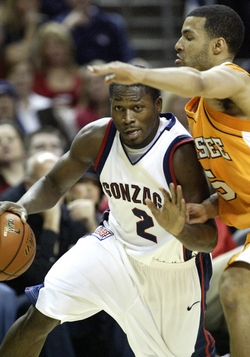
With Derek Raivio out of the picture, Pargo has taken over as Gonzagas full-time point guard, and hes certainly impressed in the early going, with his 6.1 assists per game. He still has a lot of things he could work on, but hes showing himself to be more than just a pick-and-roll point guard now. Pargo has really shown his versatility as a point guard this season, dishing out assists in many different ways, though he still has some things to work on, most notably his tendency to be too aggressive on offense, getting too deep into the paint with the ball.
In terms of scoring, Pargo is strong when attacking the basket, and that ability should translate well to the next level, where his large array of crossovers and spin moves should come in handy, along with his improvisational ability in the lane. Pargo definitely needs to show more of an ability to finish with his left hand, though, as he almost always finishes with his right, even when it makes for a tougher shot.
Pargos outside shooting is the thing he probably needs to work on the most, as hes very inconsistent from behind the arc, often missing badly on some of his attempts, air-balling or missing wide right or wide left, while hes shooting just 25% on the season. His shooting form isnt bad, and he is prone to go on some hot streaks, but he really needs to put in more practice in this area. He also can force some bad shots pulling up off the dribble here, being prone to questionable decision-making in all aspects of his offense at times.
On the defensive end, Pargo shows a lot of promise, playing intense, in-your-face defense while showing a very good ability to fight through screens, which is pretty uncharacteristic for college players. He also uses his hands well while showing good anticipation in the passing lanes, even if he can overextend at times.
Pargo still probably projects as more of a backup point guard at the next level, and at the moment looks like more of a second round pick when he finally enters the draft. With that said, with the way hes improved every season at Gonzaga, itd be foolish to rule out a brighter future for him. With his athleticism and size, if he can continuing improving all aspects of his game, he could end up playing an even bigger role at the next level, though he still has a lot of work to do.

With Derek Raivio out of the picture, Pargo has taken over as Gonzagas full-time point guard, and hes certainly impressed in the early going, with his 6.1 assists per game. He still has a lot of things he could work on, but hes showing himself to be more than just a pick-and-roll point guard now. Pargo has really shown his versatility as a point guard this season, dishing out assists in many different ways, though he still has some things to work on, most notably his tendency to be too aggressive on offense, getting too deep into the paint with the ball.
In terms of scoring, Pargo is strong when attacking the basket, and that ability should translate well to the next level, where his large array of crossovers and spin moves should come in handy, along with his improvisational ability in the lane. Pargo definitely needs to show more of an ability to finish with his left hand, though, as he almost always finishes with his right, even when it makes for a tougher shot.
Pargos outside shooting is the thing he probably needs to work on the most, as hes very inconsistent from behind the arc, often missing badly on some of his attempts, air-balling or missing wide right or wide left, while hes shooting just 25% on the season. His shooting form isnt bad, and he is prone to go on some hot streaks, but he really needs to put in more practice in this area. He also can force some bad shots pulling up off the dribble here, being prone to questionable decision-making in all aspects of his offense at times.
On the defensive end, Pargo shows a lot of promise, playing intense, in-your-face defense while showing a very good ability to fight through screens, which is pretty uncharacteristic for college players. He also uses his hands well while showing good anticipation in the passing lanes, even if he can overextend at times.
Pargo still probably projects as more of a backup point guard at the next level, and at the moment looks like more of a second round pick when he finally enters the draft. With that said, with the way hes improved every season at Gonzaga, itd be foolish to rule out a brighter future for him. With his athleticism and size, if he can continuing improving all aspects of his game, he could end up playing an even bigger role at the next level, though he still has a lot of work to do.













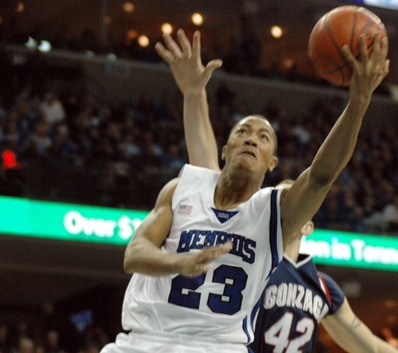


















Comments